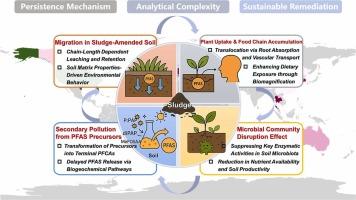Per- and polyfluoroalkyl substances in sewage sludge: A global synthesis of persistence mechanisms, analytical complexities, and sustainable remediation strategies
IF 11.3
1区 环境科学与生态学
Q1 ENGINEERING, ENVIRONMENTAL
引用次数: 0
Abstract
Per- and polyfluoroalkyl substances (PFASs), known as “forever chemicals” because of their persistent carbon–fluorine bonds, pose critical environmental risks. Sewage sludge is a major reservoir and secondary pollution source of PFASs. This review synthesizes the environmental behavior, analytical methods, global distribution, regulatory landscape, and mitigation strategies of PFASs in sludge. It also addresses complex interactions between PFAS and sludge components (organic matter, inorganic particles, extracellular polymeric substances, and microbial communities), which drive PFAS accumulation via hydrophobic interactions, ion bridging, and complexation. Analytical challenges arise from sludge heterogeneity, high moisture content, and diverse PFAS species. To address these challenges, integrated targeted/non-targeted approaches and total organic fluorine analysis are required. Global monitoring reveals stark regional disparities: U.S. sludge shows ∑PFAS up to 3,390 ng/g (dry weight) with dominant long-chain PFOS/PFOA, while Nordic countries exhibit lower levels (PFOS < 10 ng/g) owing to early regulations. Notably, the contents of short-chain PFASs and precursors (e.g., MeFOSAA and EtFOSAA) are increasing, reflecting industrial substitutions and incomplete wastewater treatment. Although regulatory frameworks are shifting from compound-specific limits (e.g., a PFOS of 5.2 ng/g in Maine, US) to class-based controls (e.g., ∑11 PFASs ≤ 3 ng/g in Sweden), many thresholds are insufficient to address contamination levels. Treatment technologies—from physical separation (adsorption and membrane treatments) and thermal destruction (incineration, pyrolysis and hydrothermal liquefaction) to advanced oxidation/reduction processes, plasma/supercritical water oxidation, and biological methods—show varying efficiencies. Thermal destruction approaches (≥650°C) achieve >99% mineralization but incur high energy costs, while biological routes achieve limited precursor transformation. Environmental fate assessments highlight three key behaviors of PFAS: migration in amended soils, plant uptake (particularly short-chain PFAS in leafy crops), and “delayed release” from precursor degradation. These behaviors threaten food chains and microbial ecosystems. Key future directions include developing high-sensitivity detection, elucidating binding mechanisms, establishing life-cycle risk models, innovating cost-effective green technologies, and advancing policy-driven management—providing a scientific basis for PFAS control and sustainable sludge utilization.

污水污泥中的全氟和多氟烷基物质:持久性机制、分析复杂性和可持续补救策略的全球综合
全氟烷基和多氟烷基物质(PFASs)因其持久的碳氟键而被称为“永远的化学品”,构成严重的环境风险。污泥是全氟磺酸的主要储存库和二次污染源。本文综述了污泥中全氟磺酸的环境行为、分析方法、全球分布、监管格局和缓解策略。它还解决了PFAS和污泥组分(有机物质、无机颗粒、细胞外聚合物物质和微生物群落)之间复杂的相互作用,这些相互作用通过疏水相互作用、离子桥接和络合作用驱动PFAS积累。分析方面的挑战来自污泥的异质性、高水分含量和PFAS种类的多样性。为了应对这些挑战,需要综合的目标/非目标方法和总有机氟分析。全球监测显示了明显的地区差异:美国污泥显示∑PFAS高达3,390 ng/g(干重),主要是长链PFOS/PFOA,而北欧国家由于早期法规而表现出较低的水平(PFOS + lt; 10 ng/g)。值得注意的是,短链PFASs和前体(如MeFOSAA和EtFOSAA)的含量正在增加,这反映了工业替代和废水处理不完全。尽管监管框架正在从特定化合物的限制(例如,美国缅因州的全氟辛烷磺酸为5.2 ng/g)转变为基于类别的控制(例如,瑞典的∑11全氟辛烷磺酸≤3 ng/g),但许多阈值不足以解决污染水平。处理技术——从物理分离(吸附和膜处理)和热破坏(焚烧、热解和水热液化)到高级氧化/还原工艺、等离子体/超临界水氧化和生物方法——显示出不同的效率。热破坏方法(≥650°C)可实现99%的矿化,但能源成本高,而生物途径可实现有限的前体转化。环境命运评估强调了PFAS的三个关键行为:在改良土壤中的迁移,植物吸收(特别是叶作物中的短链PFAS),以及前体降解的“延迟释放”。这些行为威胁着食物链和微生物生态系统。未来的关键方向包括开发高灵敏度检测、阐明结合机制、建立全生命周期风险模型、创新具有成本效益的绿色技术以及推进政策驱动管理——为PFAS控制和污泥可持续利用提供科学依据。
本文章由计算机程序翻译,如有差异,请以英文原文为准。
求助全文
约1分钟内获得全文
求助全文
来源期刊

Journal of Hazardous Materials
工程技术-工程:环境
CiteScore
25.40
自引率
5.90%
发文量
3059
审稿时长
58 days
期刊介绍:
The Journal of Hazardous Materials serves as a global platform for promoting cutting-edge research in the field of Environmental Science and Engineering. Our publication features a wide range of articles, including full-length research papers, review articles, and perspectives, with the aim of enhancing our understanding of the dangers and risks associated with various materials concerning public health and the environment. It is important to note that the term "environmental contaminants" refers specifically to substances that pose hazardous effects through contamination, while excluding those that do not have such impacts on the environment or human health. Moreover, we emphasize the distinction between wastes and hazardous materials in order to provide further clarity on the scope of the journal. We have a keen interest in exploring specific compounds and microbial agents that have adverse effects on the environment.
 求助内容:
求助内容: 应助结果提醒方式:
应助结果提醒方式:


